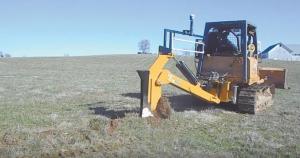2018 - Volume #42, Issue #3, Page #36
[ Sample Stories From This Issue | List of All Stories In This Issue | Print this story
| Read this issue]
Micro Drainage Catching On Fast
 |
In fact, he remembers talking about the idea with Mark Martin before it became a reality. Martin developed a 3-pt. mounted plow for MDC (micro drainage concept) with his nephew Elton Zimmerman (Vol. 37, No. 2). Buckholder was the first to put the prototype plow and MDC to work.
“About 8 years ago, we installed it on 10 acres with all the laterals on contours,” recalls Buckholder. “Our land is rolling with slopes from 0 to 6 percent. With their articulated plow, they can make a pretty tight curve, which is important for contours.”
“Micro drainage calls for 2-in. lateral lines buried only 2 ft. deep on 20-ft. or less centers with main lines as little as 6 in. in diameter and buried only 3 ft. deep,” explains Zimmerman, who co-founded Richland Micro Drainage with his uncle.
Most conventional drainage is with 4-in. laterals buried deeper and on 40-ft. centers. While MDC uses more tile, it is less expensive tile and requires a smaller, less expensive plow.
After his initial installation, Buckholder did another 100 acres. “Conventional tiling contractors charged 22 to 24˘ per foot, while Richland charged 12 to 15˘ per foot,” says Buckholder. “They use a smaller tractor and a 2-man crew. Conventional contractors use larger tractors and usually have one guy getting the grade, 2 guys hooking up tile with one on the plow and often with the farmer pulling a tile cart.”
Eight years later, he remains enthused about the concept and says others in the area are as well. “I don’t know anyone who had deep drainage that has tried this and then gone back to the old way,” says Buckholder. “They’re all tickled with the shallow drainage.”
One reason, he notes, is the improved drainage. “When a bare field dries down, you see the tile lines with conventional tiling,” he says. “That is hardly possible with this system. It all dries down at a uniform rate.”
Other benefits cited by Burkholder and Richland Micro Drainage include better root development, less compaction and better soil health. Faster infiltration and dry down gets operators back in the field sooner after rains.
For the first few years after introducing MDC, Martin and Zimmerman made the equipment needed and laid tile. In the years since, drainage contractors from New York, Pennsylvania, Ohio and Missouri have adopted MDC. Today the two are focusing more effort toward educating contractors and farmers to the concept.
“We realize we need to help people understand why MDC Is better,” says Zimmerman. “We are also working with custom installers and letting them use our trademark.”
Richland Micro Drainage has added a dozer mounted plow requiring even fewer horsepower and creating even less compaction than their wheeled tractor system. They also plan to start producing their own 2-in. poly pipe this coming September with a price projected at half current pipe costs.
Contact: FARM SHOW Followup, Richland Micro Drainage, 8105 Malone Rd., Shiloh, Ohio 44878 (ph 419 908-5696 or 419 896-3623; www.richlandmicrodrainage.com).

Click here to download page story appeared in.

Click here to read entire issue
To read the rest of this story, download this issue below or click here to register with your account number.




